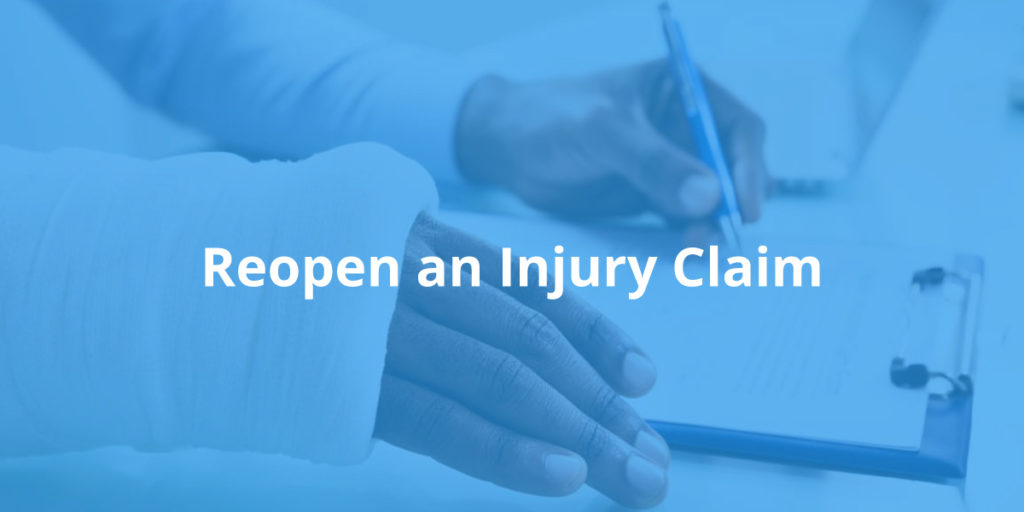Can You Reopen an Injury Claim?


Is It Possible To Reopen A Personal Injury Case?
The answer to this question is ultimately going to depend on the unique factors pertaining to your case and overall settlement terms. In general, it isn’t possible to reopen an injury claim after a settlement or judgment has been officially negotiated upon by all parties and their insurance providers. There are limited occasions when they may be reopened.
The reason why it’s difficult to reopen personal injury cases is that most settlements include a “release of liability” that requires the plaintiff’s consent, which they’ll sign off on prior to obtaining their rightful compensation. The release is a written agreement between the parties. It includes a promise to pay money to an injured person. In exchange, the injured person agrees to give up a lawsuit or legal claims against the person who caused an accident.
Our team of experienced personal injury attorneys has helped many clients throughout Pennsylvania and New Jersey negotiate favorable final settlements, and we also know when reopening a personal injury claim may be possible, feasible, and worthwhile.
On this page, we’re going to discuss the details of the “release of liability” and the possible exceptions when it comes to reopening a finalized personal injury case. When you contact us for a free case review we’ll be able to evaluate your situation and help you better understand what your legal options are in terms of reopening your case.
What You Should Know About In Terms Of “Release of Liability”
A release of liability is a common and obvious clause within any settlement agreement for personal injury claims. The written terms of a release generally state that in exchange for payment of an agreed-upon amount of money the defendant is released of all liability related to the case (assuming they’ve fulfilled the settlement terms).
Essentially, once a defendant and their insurance provider pay the plaintiff the agreed-upon compensation for the plaintiff’s damages, the plaintiff will not be able to sue the defendant again for any additional damages. Even if a plaintiff agrees to settle a lawsuit for an amount of money and then later finds out that he or she has additional injuries caused by an accident, the release would usually prevent the plaintiff from going back to the defendant and attempting to get more money.
It’s also important to understand that certain verbal agreements with insurance providers and defendants can possibly be enforceable as a “release of liability.” This is why it is important to be very specific when negotiating so that the terms of any agreement are crystal clear ensure there is no acceptance until and unless all of the conditions that a plaintiff requires are met.
Once a plaintiff agrees to terms, signs a release, and receives money in exchange for that release the case is considered settled. It can be reopened for limited reasons.
Exceptions To Reopening An Injury Claim
There are certain circumstances that allow plaintiffs to reopen an injury claim for additional damages, even when an original settlement agreement has been negotiated. These reasons are usually limited to fraud, duress, accident or mutual mistake. See Buttermore v. Aliquippa Hosp., 522 Pa. 325, 330, 561 A.2d 733, 735 (1989).
Fraud would involve some kind of deceit or lie in order to convince a plaintiff to settle a claim. For example, if a person misrepresented the presence of available insurance or lied about the amount of insurance available to get a plaintiff to agree to a lesser amount, that could constitute fraud. The facts of the alleged deception would need to be evaluated to see if a case could be reopened and a release declared void.
Accident or mutual mistake is also very fact-specific inquiries. The mistake could involve a situation where a person was simply wrong about the amount of insurance they had under their own policy, like an underinsured (UIM) policy. In Lanci v. Metro. Ins. Co., 388 Pa. Super. 1, 6, 564 A.2d 972, 974 (1989), a release was voided when an injured person settled a case for an amount that he mistakenly believed was the policy limits. His own insurance company knew that there was more available and allowed the plaintiff to settle a case for only $15,000. The Court threw out the release, holding that forcing the release to be honored would be unconscionable and that the insurance company had knowledge that the plaintiff was mistaken in thinking there was only $15,000 in coverage.
Duress would involve specific situations in which improper pressure was put on a plaintiff to settle a case. Whether by threats or otherwise, duress may be sufficient to void a release.
Other than these specific exceptions, it can be extremely difficult to reopen a case once it has been settled, a release signed, and money paid. But there are also some things to keep in mind before agreeing to a release in the first place to avoid needing to reopen a case at all.
First, know your damages. Get an experienced attorney to evaluate the full extent of your injuries and damages. This may include getting expert reports from physicians, economists, vocational experts, or others to determine all of the injuries you sustained, whether there is a chance of additional complications in the future, whether you may need future treatment, and whether you have or will have economic losses in the future as well, including lost wages and medical bills. Having this information before attempting to settle a case will help determine the most accurate range for a potential settlement value in the first place.
Second, make sure you are very clear when determining the terms of the settlement. One common way to protect a plaintiff’s rights is to set certain specific conditions as part of the settlement agreement. If a defendant later attempts to add conditions into a written release, such as confidentiality, which were not raised when initially accepting a settlement amount, there is an argument that the settlement is invalid or that the parties are not in agreement.
Another common circumstance that can cause an issue when settling a case is when there are other possible parties that the plaintiff can hold legally liable for their injuries and subsequent damages, which weren’t included as defendants in the settlement. If you are not settling your case against everyone who could be responsible for your injuries or damages, then you should specify in the release that only certain people or parties are being released. Do not include broad or general language releasing any and all parties. If so, you may be releasing others who did not even contribute to the settlement.
A common example of leaving a potential injury claim open would be the use of a joint-tortfeasor release. This is a release that specifically states that only certain defendants are being released under the agreement. Other people who may have caused or contributed to the accident are not released, and the terms of the written release specify this fact. This way, an injured plaintiff can still pursue potential claims against others even after settling a portion of the case against one defendant.
Another possible exception to obtaining additional compensation for a settled injury claim is when a plaintiff files a lawsuit against their previous lawyer for professional malpractice. This could occur if a plaintiff has a reasonable belief that he or she agreed to an insufficient settlement amount due to their legal counsel’s inappropriate/incompetent suggestions. If a plaintiff believes and has evidence that his or her lawyer violated the standard of care and acted negligently when handling the original personal injury case, and that the plaintiff agreed to an unfair settlement amount because of bad legal advice, there is at least a possibility of obtaining additional money through a malpractice action.
In this situation, a plaintiff will likely not be able to sue the original defendant again. Any additional money that would have to be sought from the plaintiff’s former lawyer. What would happen if a plaintiff is successful in suing his or her former lawyer for malpractice in order to obtain full compensation? Malpractice claims are challenging and would need to be thoroughly evaluated.
Settling for less than the full compensation that a person is entitled to be more common than many people would think. Reopening an injury claim is never an easy task, and it is vitally important to hire an experienced lawyer who can help you in fully identifying and quantifying the uncalculated damages and potentially third parties that will allow you to reopen your injury claim.
The best thing you can do when it comes to obtaining the full and rightful compensation for a personal injury claim is to hire an experienced legal team as soon as you can. Our experienced personal injury firm has years of experience negotiating settlements for our clients in complex and straightforward cases. We can help get you the full compensation that is fair for your case.
Contact Us Today For A Free Consultation
At Mattiacci Law, LLC, our attorneys have helped hundreds of clients obtain compensation from negligent parties. We have worked to hold defendants accountable and to get money for our clients’ damages.
If you or a loved one has a personal injury claim, or if you have any reason to believe that there is a reason why a prior case should be examined to see if it can be reopened, contact us today for a free consultation so we can go over the details of your settlement and damages and help you evaluated any potential claims.
